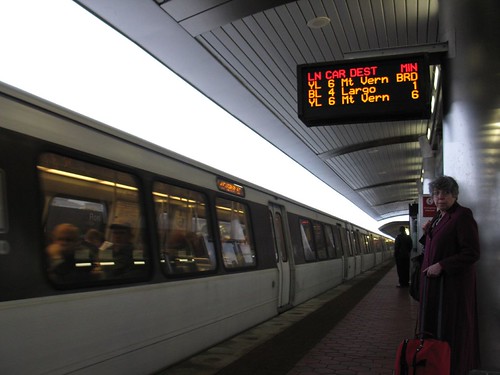 It must be tough to live through day one at the helm of the MTA. In a city of know-it-alls, everyone wants to be the first, second or even third person to tell you how to do your job, and Jay Walder yesterday was no exception.
It must be tough to live through day one at the helm of the MTA. In a city of know-it-alls, everyone wants to be the first, second or even third person to tell you how to do your job, and Jay Walder yesterday was no exception.
Fresh off the plane from England and living on little sleep, Walder took the reins of the MTA and promised big changes. But first, he needs an action plan. “By the end of my first 100 days at the MTA, we will produce an action plan for moving forward with concrete goals and timelines,” Walder said to reporters on Monday. “We will make the objectives clear and the communities we serve should hold us accountable for achieving real results.”
Who wants to wait for Walder though? Heather Haddon of amNew York offered up her brief list of priorities, and Gene Russianoff and the Straphangers, in a press release not available online, also listed what they consider to be Walder’s priorities. The Straphangers’ list is fairly typical: Block maintenance and station agent cuts; improve bus service; utilize the line manager program; support public authority oversight. Ho hum.
With this lists in mind, I’m going to — surprise! surprise! — offer up my own list of the top five initiatives that Walder should tackle. He doesn’t need 100 days to put this action plan together, and in fact, at least one of these suggestions could be accomplished before the 100 days is up.
1. Overhaul the MTA’s Website
This particular initiative is really not that ground-breaking, and yet, it is a topic upon which I have harped for years. As I said in January, the MTA’s website pales in comparison with those of its competitors. When we examine the WMATA’s site, Transport for London’s homepage and the Chicago Transit Authority’s site, we see transit network websites designed with clear interfaces, easy-to-find trip planners and information at our fingertips. When we look at the MTA’s Internet home, we see a mess.
To make matters worse, the MTA’s site hasn’t really improved its look in six years. Don’t believe me? Take a look at its homepage from Oct. 8, 2003. The site has more information than it did during the early 2000s, but the look and navigation remain outdated and impossible to use.
Overhauling the MTA’s website will give the agency a much better public face and presence on the Internet. It’s 2009; those qualities go without say.
2. Open MTA data
In mid-September, I explored how the MTA is struggling in an age of open information. They had been pursuing spurious copyright claims against iPhone application developers, and while these actions have since ceased on the part of the transit agency, the data remains inaccessible. Hand in hand with a website redesign is an overhaul of the MTA’s data policies. The agency should open its scheduling information to developers and allow them to run wild with it. It can only contribute to transit interest and ridership demands.
3. Come clean on the Second Ave. Subway
When the Second Ave. Subway project got off the ground earlier this decade, Phase I was supposed to open in 2012, and the other Phases were to follow by 2020. On the precipice of 2010, we now know that Phase I may not open until 2018, and the other Phases remain unfunded ideas. In fact, in its next five-year capital plan, the MTA is requesting funds to finish Phase I but no money for Phase II or beyond.
While the MTA Inspector General is working on a report, Walder should commission an internal review of the Capital Construction department. Why is this project six years behind schedule and counting? What can be to speed up the pace of construction and restore a drive to see a full Second Ave. Subway with the next 10 or 15 years? What is wrong with the MTA’s process that multi-year delays plaguing multi-billion-dollar projects become the norm rather than exception?
4. Improve Surface Transit
New York City Transit’s buses are so slow that the Straphangers award them medals for lack of speed. Meanwhile, our city streets are so congested with unnecessary cars that buses can’t get anywhere. Make a strong push to reclaim the streets for transit. There is no reason that every avenue in Manhattan without a subway line under it can’t have Select Bus Service by the end of next year or 2011. There is no reason why outer borough thoroughfares should be held captive to automobile traffic at the expense of those using the buses. It might even be time to take a look at Vision42’s plan to remove cars from 42nd St. Since subway line construction is proving fiscally impractical right now, Walder should become a drive to give substantial surface space to bus lines.
5. Look to the Future
In early 2008 as part of the celebration of the 40th anniversary of the MTA, then-CEO and Executive Director Elliot Sander unveiled an ambitious if impossible 40-year plan to bring transit to, well, everywhere. In his vision, the major avenues would feature physically separated bus lanes, and a TriboroRX line would connect underserved areas in Brooklyn, Queens and the Bronx. To many this plan is but a dream, but as Walder takes over, he should keep that dream in mind. While the subways need a lot of work today, we can’t be afraid of pushing for a better future. Only by keeping those goals in mind can we realize and overcome the problems facing a healthy and vibrant transit system in New York City.



















 Earlier this week, I briefly touched upon a
Earlier this week, I briefly touched upon a